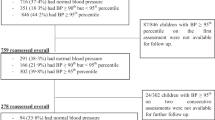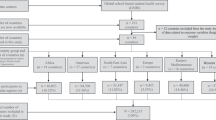Abstract
Objectives:
To estimate the prevalence and determinants of obesity in childhood and adolescence and their association with blood pressure (BP) in Abu Dhabi, United Arab Emirates (UAE).
Design:
A cross-sectional population-representative study.
Subjects:
A total of 1541 students (grades 1–12; aged 6–19 years) were randomly selected from 246 schools (50% male). Anthropometric and demographic variables were measured, and CDC criteria were used to classify children’s weights.
Results:
A total of 1440 (93%) students provided complete results. Crude prevalences were: 7.6% underweight, 14.7% overweight and 18.9% obesity. Further analyses were restricted to UAE nationals (n=1035), of whom these figures were: 8.3% underweight (females 6.5%, males 10.1%; P=0.06), 14.2% overweight (females 16.7%, males 11.6%; P<0.01), 19.8% obesity (females 18.1%, males 21.4%; P=0.09). Obesity significantly (P<0.001) increased with age. The majority (61.3%) of students had body mass index (BMI) percentiles above the 50th CDC percentile. Stepwise linear regression of BMI percentile on age, sex, dairy consumption, exercise and family income showed a significant (P<0.01) positive association with age and lack of dairy consumption, but not exercise and income. BP significantly (P<0.01) increased with BMI percentile.
Conclusions:
The prevalence of childhood obesity is high across the age spectrum in the UAE. Older age, male sex, lack of dairy intake and higher parental BMI, are independent determinants of childhood obesity in this population. Higher BMI percentile is associated with a higher BP. Prevention strategies should focus on younger children, particularly children of obese parents. Longitudinal studies are needed to investigate trends and the impact of childhood obesity on the risk of non-communicable diseases.
This is a preview of subscription content, access via your institution
Access options
Subscribe to this journal
Receive 12 print issues and online access
$259.00 per year
only $21.58 per issue
Buy this article
- Purchase on Springer Link
- Instant access to full article PDF
Prices may be subject to local taxes which are calculated during checkout



Similar content being viewed by others
References
Wang Y, Lobstein T . Worldwide trends in childhood overweight and obesity. Int J Pediatr Obes 2006; 1: 11–25.
Prentice AM . The emerging epidemic of obesity in developing countries. Int J Epidemiol 2006; 35: 93–99.
Malik M, Bakir A . Prevalence of overweight and obesity among children in the United Arab Emirates. Obes Rev 2007; 8: 15–20.
Whitaker RC, Wright JA, Pepe MS, Pepe MS, Seidel KD, Dietz WH . Predicting obesity in young adulthood from childhood and parental obesity. N Engl J Med 1997; 337: 869–873.
Guo SS, Chumlea WC . Tracking of body mass index in children in relation to overweight in adulthood. Am J Clin Nutr 1999; 70: 145S–148S.
Freedman DS, Dietz WH, Srinivasan SR, Berenson GS . The relation of overweight to cardiovascular risk factors among children and adolescents: the Bogalusa Heart Study. Pediatrics 1999; 103: 1175–1182.
Must A, Jacques PF, Dallal GE, Bajema CJ, Dietz WH . Long-term morbidity and mortality of overweight adolescents. A follow-up of the Harvard Growth Study of 1922 to 1935. N Engl J Med 1992; 327: 1350–1355.
Gidding SS, Bao W, Srinivasan SR, Berenson GS . Effects of secular trends in obesity on coronary risk factors in children: the Bogalusa Heart Study. J Pediatr 1995; 127: 868–874.
Sinha R, Fisch G, Teague B, Tamborlane WV, Banyas B, Allen K et al. Prevalence of impaired glucose tolerance among children and adolescents with marked obesity. N Engl J Med 2002; 346: 802–810.
Pinhas-Hamiel O, Dolan LM, Daniels SR, Standiford D, Khoury PR, Zeitler P . Increased incidence of non-insulin-dependent diabetes mellitus among adolescents. J Pediatr 1996; 128: 608–615.
Skelton JA, Irby MB, Grzywacz JG, Miller G . Etiologies of obesity in children: nature and nurture. Pediatr Clin North Am 2011; 58: 1333–1354.
Trainer SS . Body image, health, and modernity: women’s perspectives and experiences in the United Arab Emirates. Asia Pac J Public Health 2010; 22: 60S–67S.
Omran AR, Roudi F . The Middle East population puzzle. Popul Bull 1993; 48: 1–40.
Al-Haddad F, Al-Nuaimi Y, Little BB, Thabit M . Prevalence of obesity among school children in the United Arab Emirates. Am J Hum Biol 2000; 12: 498–502.
Al-Hourani HM, Henry CJK, Lightowler HJ . Prevalence of overweight among adolescent females in the United Arab Emirates. Am J Hum Biol 2003; 15: 758–764.
Al-Matroushi MA, Fikry M UAE-GSHS United Arab Emirates Global School-based Student Health Survey 2005. http://www.who.int/chp/gshs/2005_United_Arab_Emirates_GSHS_Country_Report.pdf.
Kuczmarski RJ, Ogden CL, Grummer-Strawn LM, Flegal KM, Guo SS, Wei R et al. CDC growth charts: United States. Adv Data 2000; 314: 1–27.
Reilly JJ . Assessment of childhood obesity: national reference data or international approach? Obes Res 2002; 10: 838–840.
Winkler J, Stolzenberg H . [Social class index in the Federal Health Survey]. Gesundheitswesen 1999; 61: 178–183.
Lange M, Kamtsiuris P, Lange C, Schaffrath RA, Stolzenberg H, Lampert T . [Sociodemographic characteristics in the German Health Interview and Examination Survey for Children and Adolescents (KiGGS) - operationalisation and public health significance, taking as an example the assessment of general state of health]. Bundesgesundheitsblatt Gesundheitsforschung Gesundheitsschutz 2007; 50: 578–589.
O’Brien E, Beevers G, Lip GY . ABC of hypertension: blood pressure measurement. Part IV-automated sphygmomanometry: self blood pressure measurement. BMJ 2001; 322: 1167–1170.
National High Blood Pressure Education Program Working Group on High Blood Pressure in Children and Adolescents The fourth report on the diagnosis, evaluation, and treatment of high blood pressure in children and adolescents. Pediatrics 2004; 114: 555–576.
van der Ploeg HP, Tudor-Locke C, Marshall AL, Craig C, Hagströmer M, Sjöström M et al. Reliability and validity of the international physical activity questionnaire for assessing walking. Res Q Exerc Sport 2010; 81: 97–101.
Craig CL, Marshall AL, Sjöström M, Bauman AE, Booth ML, Ainsworth BE et al. International physical activity questionnaire: 12-country reliability and validity. Med Sci Sports Exerc 2003; 35: 1381–1395.
Baba N, Shaar K, Faour D . Nutritional status of school children aged 6-10 years in United Arab Emirates: Comparison with children from different ethnic origins. Ecol Food Nutr 1997; 36: 367–384.
Ng SW, Zaghloul S, Ali H, Harrison G, Yeatts K, El Sadig M et al. Nutrition transition in the United Arab Emirates. Eur J Clin Nutr 2011; 65: 1328–1337.
Ogden CL, Carroll MD, Kit BK, Flegal KM . Prevalence of obesity and trends in body mass index among US children and adolescents, 1999-2010. JAMA 2012; 307: 483–490.
Musaiger AO, Al-Ansari M, Al-Mannai M . Anthropometry of adolescent girls in Bahrain, including body fat distribution. Ann Hum Biol 2000; 27: 507–515.
Al-Isa AN . Body mass index, overweight and obesity among Kuwaiti intermediate school adolescents aged 10-14 years. Eur J Clin Nutr 2004; 58: 1273–1277.
Kelishadi R, Ardalan G, Gheiratmand R, Majdzadeh R, Hosseini M, Gouya MM et al. Thinness, overweight and obesity in a national sample of Iranian children and adolescents: CASPIAN Study. Child Care Health Dev 2008; 34: 44–54.
Sibai AM, Hwalla N, Adra N, Rahal B . Prevalence and covariates of obesity in Lebanon: findings from the first epidemiological study. Obes Res 2003; 11: 1353–1361.
Wronka I . Growth and development of overweight and obese girls. Pediatr Endocrinol Diabetes Metab 2011; 17: 125–128.
Moore LL, Bradlee ML, Gao D, Singer MR . Low dairy intake in early childhood predicts excess body fat gain. Obesity 2006; 14: 1010–1018.
Phillips SM, Bandini LG, Cyr H, Colclough-Douglas S, Naumova E, Must A . Dairy food consumption and body weight and fatness studied longitudinally over the adolescent period. Int J Obes Relat Metab Disord 2003; 27: 1106–1113.
Dugee O, Khor GL, Lye M-S, Luvsannyam L, Janchiv O, Jamyan B et al. Association of major dietary patterns with obesity risk among Mongolian men and women. Asia Pac J Clin Nutr 2009; 18: 433–440.
Davis MM, McGonagle K, Schoeni RF, Stafford F . Grandparental and parental obesity influences on childhood overweight: implications for primary care practice. J Am Board Fam Med 2008; 21: 549–554.
Flechtner-Mors M, Thamm M, Rosario AS, Goldapp C, Hoffmeister U, Mann R et al. [Hypertension, dyslipoproteinemia and BMI-category characterise the cardiovascular risk in overweight or obese children and adolescents: data of the BZgA-observational study (EvAKu-J-project) and the KiGGS-study]. Klin Padiatr 2011; 223: 445–449.
Henry CJK, Lightowler HJ, Al-Hourani HM . Physical activity and levels of inactivity in adolescent females ages 11-16 years in the United Arab Emirates. Am J Hum Biol 2004; 16: 346–353.
Amine EK, Samy M . Obesity among female university students in the United Arab Emirates. J R Soc Health 1996; 116: 91–96.
Ali HI, Baynouna LM, Bernsen RM . Barriers and facilitators of weight management: perspectives of Arab women at risk for type 2 diabetes. Health Soc Care Community 2010; 18: 219–228.
Melnyk BM . Addressing the globesity crisis: dream, discover, and deliver solutions. Childhood Obesity 2010; 6: 169–169.
Acknowledgements
This research was supported by a grant from Medical Services Corps, UAE Armed Forces. We wish to thank Brig. Dr Rashid Al Nuaimi, Director of Medical Services Corps, and Professor Mohamed YH Baniyas, Provost, UAE University, for their support in providing much needed resources during the course of this research. We also wish to thank Professor Masood Badri, Head of Research, Planning & Performance Management and Dr Mubarak Al Darmaki, Manager, Health Management Section, Abu Dhabi Education Council for facilitating the recruitment process. We wish to thank Dr Ali Al Obaidli, Director, Clinical Affairs; Dr Najah Mustapha; Director of School Health and Dr Jamal Aljubeh, Pediatric endocrinologist, Abu Dhabi Health Services Co (SEHA) for their invaluable advice. Our gratitude goes to the volunteers (students and parents) and the school nurses who participated in the data collection process.
Author information
Authors and Affiliations
Corresponding author
Ethics declarations
Competing interests
The authors declare no conflict of interest.
Rights and permissions
About this article
Cite this article
Al Junaibi, A., Abdulle, A., Sabri, S. et al. The prevalence and potential determinants of obesity among school children and adolescents in Abu Dhabi, United Arab Emirates. Int J Obes 37, 68–74 (2013). https://doi.org/10.1038/ijo.2012.131
Received:
Revised:
Accepted:
Published:
Issue Date:
DOI: https://doi.org/10.1038/ijo.2012.131
Keywords
This article is cited by
-
Accelerometer measured physical activity patterns of children during segmented school day in Abu Dhabi
BMC Pediatrics (2021)
-
Trends in the prevalence of twenty health indicators among adolescents in United Arab Emirates: cross-sectional national school surveys from 2005, 2010 and 2016
BMC Pediatrics (2020)
-
Physical activity and sedentary behaviour in the Middle East and North Africa: An overview of systematic reviews and meta-analysis
Scientific Reports (2020)
-
Prevalence of obesity among school-age children and adolescents in the Gulf cooperation council (GCC) states: a systematic review
BMC Obesity (2019)
-
Nutritional status of school children in eastern Hararghe administrative zone, eastern Ethiopia
Journal of Public Health (2019)



